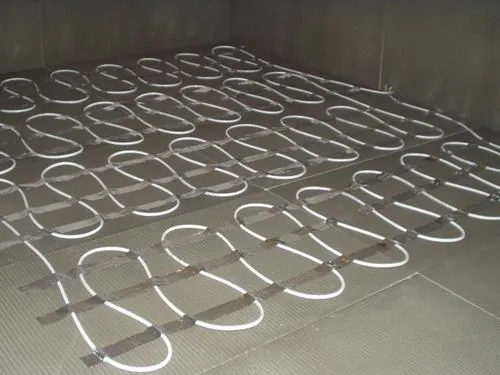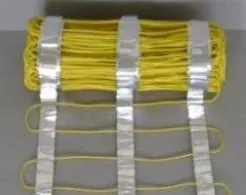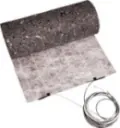When the leaves begin to change and the air becomes cooler, homeowners everywhere acknowledge that winter is afoot.

For many people, this is a time of cozy sweaters, warm fires, and going to great lengths to avoid drafty spaces and cold surfaces. Unfortunately, most homes seem afflicted with a few spots that just never seem to stay warm. Wouldn't it be nice to eliminate all those creeping chills? With radiant floor heating, homeowners are one step closer to dream homes that do just that.

Radiant floor heating consists of tubing that circulates warm air, water, or electricity within the home's flooring. The old system of forced air registers would allow blown air to rise along walls, filling cathedral ceilings and unoccupied second floors. This is a great drain on energy and finances. The use of radiant floor heating often allows thermostats to be set at lower temperatures as the heat rises from the floor and circulates immediately closer to the occupants.

Radiant floor heating that circulates warm air is not cost-effective for home application, so most residences turn toward hydronic and electric systems. Hydronic systems are capable of heating the entire home from the smallest closet to the concrete garage floor. Tubing is laid in a pattern beneath the floor. Temperatures in rooms are maintained by regulating hot water flow through the pipes via a series of valves, pumps, and thermostats.
Electric radiant heat is simpler to install as it does not require the same pipe system as hydronic, but may be most cost-effective in smaller applications. However, some utility companies may offer time-of-use rates. This would allow homeowners to "charge" the floor during off-peak hours. Flooring with a large enough thermal mass should be able to give off the stored heat over the next 8 to 10 hours. This would save numerous resources.

When considering radiant floor heating, it is important to keep in mind the flooring surfaces homeowners want to incorporate into their interior design. Ceramic tile, vinyl, and wood are the most popular and effective surfaces. Carpeting is an option, but padding and carpet do insulate the floor and limit some of the benefits of such a floor heating system.
Though initially more expensive, radiant floor heating has numerous benefits that certainly make it a worthwhile investment. Beyond basic comfort, radiant floor heating is quieter and often a healthier option for families with allergy sufferers. The absence of drafts and pushed air keeps fewer allergens from permeating living spaces, creating a healthier atmosphere over all. Additionally, these systems are virtually maintenance free and incredibly reliable.
The prospect of hiding an entire heating system within one's floorboards may seem quite daunting. To maximize the efficiency of your system, it is important to consult professionals for planning and installation. A detailed heat-loss analysis will need to be performed to ensure typically drafty spots are turned into warm zones. Professional help will ensure that potential problems are eliminated before they arise. With just a little information and some detailed planning, no homeowner need ever fear the chills of winter again.
Here are some related articles:
Save this article to:
back to top